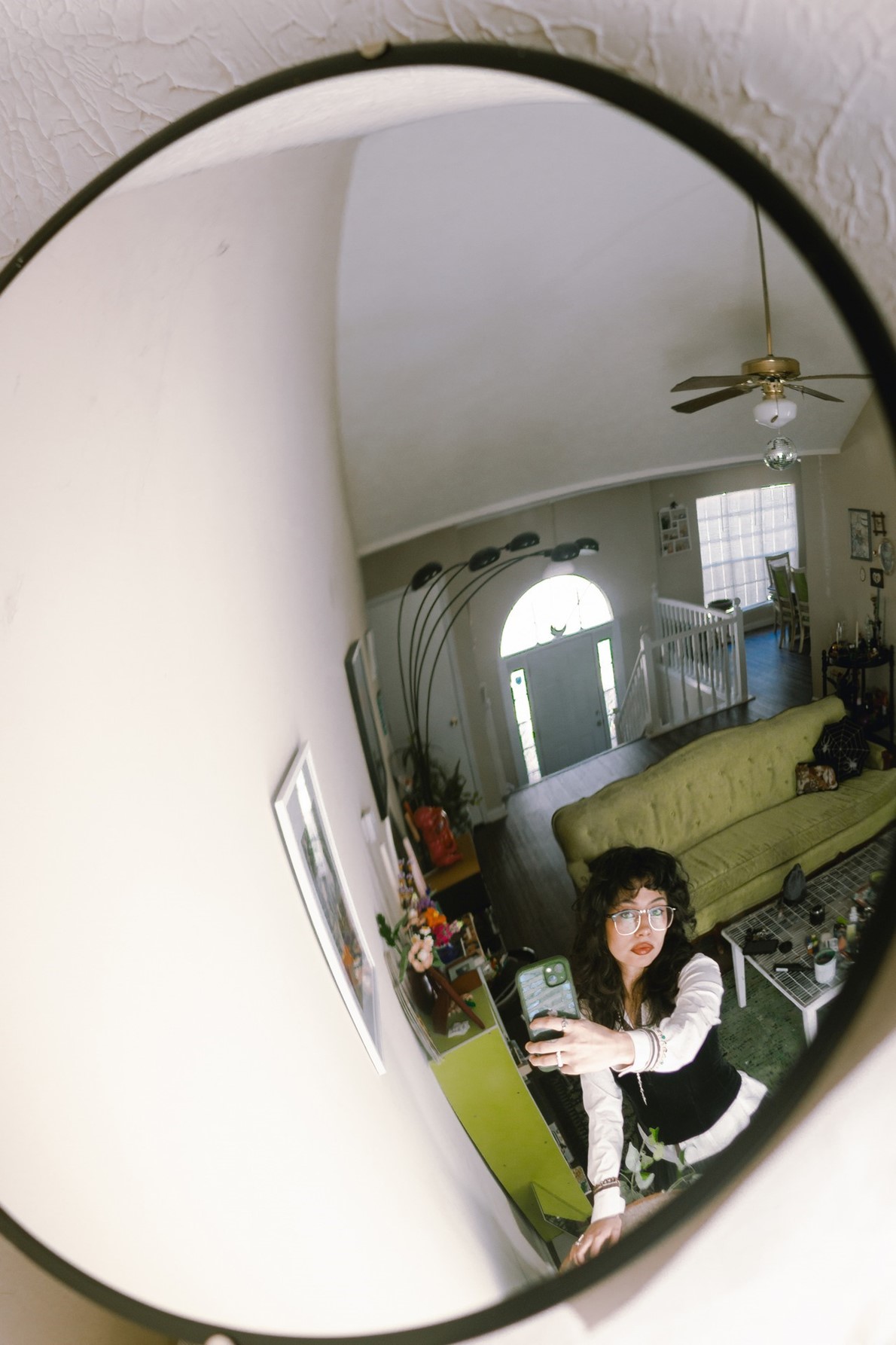Mercedes Jimenez-Cortes often takes
pictures of herself in the domed mirrors that hang in parking garages. The
mirrors turn an everyday scene surreal, bending concrete like it is jelly and
exaggerating the size of Jimenez-Cortes’ face or her iPhone.
اضافة اعلان
Jimenez-Cortes, 24, who works for grocery
delivery company Instacart and lives in Atlanta, US, liked the look of the
mirrors so much that she recently purchased one for her apartment. The
stylishly named PLX18 Circular Acrylic Indoor Convex Security mirror cost $37
on Amazon, and came equipped with a swivel mounting bracket to extend its range
of visibility in loading docks and driveways. Jimenez-Cortes hung the mirror
near a disco ball in her living room, where her cat, Pixie, uses it to gaze at
his own contorted reflection.
“It looks funny,” Jimenez-Cortes said. “But
it looks funny on purpose.”
 As
the #NoFilter trend wanes, young people are experimenting with new ways to warp
images of themselves online.
As
the #NoFilter trend wanes, young people are experimenting with new ways to warp
images of themselves online.
So goes Gen Z’s latest approach to the
self-portrait. The #NoFilter selfie is out, and obvious, goofy distortion is
in. There is the 0.5 ultra-wide-angle lens for extreme forced perspective; the
AI portrait generator for rendering you like a painting; and the lo-fi digital
camera for a grainy, nostalgic quality. Some young people in search of these
effects are also turning to an item better known for capturing interstates than
influencers: the traffic mirror.
‘Bus driver core’You have seen these mirrors before.
Sometimes called blind-spot mirrors, they wing out from school buses and
eighteen-wheelers. They are also often used as safety or security mirrors,
allowing attendants at grocery stores and subway stations to keep watch over a
wide area. They are probably most accurately described as convex mirrors, but
on TikTok, a platform adept at warping language, they have become known as
traffic mirrors.
The #NoFilter selfie is out, and obvious, goofy distortion is in.
Jimenez-Cortes said she sees the mirrors
all over the app, where they are being pitched as both a selfie tool and
low-cost home décor hack. The hashtag #trafficmirror, which has more than 20
million views, appears alongside ones like #inspo, #roomdesign, and #aesthetic.
The mirrors are sometimes included in TikTok video roundups from streetwear
accounts and praised by commenters as “bus driver core”.
“There has indeed been a slight upward
trend in sales lately,” Stylianos Peppas, the director of SNS Safety Ltd., a
traffic and parking safety company in London that sells convex mirrors through
Amazon, wrote in an email. He said he thought the mirrors had been selling well
“because people are increasingly concerned about the safety of themselves and
their families.”
But social media suggests a less-practical
motivation. On Pinterest, searches for “convex mirror” were four times higher
in December than they had been a year earlier, according to Swasti Sarna, the
company’s global director of data insights.
That traffic mirrors have not historically been fashionable is part of their appeal.
That traffic mirrors have not historically
been fashionable is part of their appeal. Cheap, ordinary, and conspicuously
out of place in a bedroom or Instagram feed, the mirrors add a layer of
irreverence to photos.
From perfection to distortionThe way the mirrors distort the face and
body can take some of the pressure off looking perfect, said Allie Rowbottom,
the author of “Aesthetica”, a 2022 novel about an influencer who tries to undo
years of cosmetic surgery.
The proliferation of apps like Facetune to
smooth pores and cinch waists beyond the point of possibility brought about a
#NoFilter backlash that seemed to emphasize authenticity. But even some of that
so-called realness still required self-manipulation. Looking “absolutely
bizarro” online is Gen Z’s rejection of both approaches, Rowbottom said.
“We’ve exited the conventional era of the
selfie that began in 2012, 2013 with the advent of Instagram,” she said.
The history of distorted portraiture,
however, predates social media. Italian painter Parmigianino was about 21 when
he painted his “Self-Portrait in a Convex Mirror” in 1524. Parmigianino used
two barbers’ mirrors that exaggerated the size of his hand and made the horizon
behind him appear curved and off-kilter.
The ultrawide angle of the lens could contain a fast-moving skateboarder, Missy Elliott’s entire Hummer, or a rooftop full of Beastie Boys.
Much later, when Nikon’s first fish-eye
camera lens became broadly available to consumers in 1962, similar images
became a fixture of pop culture. In the 1960s, fish-eye lenses were used to
photograph album covers for Jimi Hendrix and the Rolling Stones, and to
document the trippiness of Woodstock.
A new heyday for the fish-eyeBut the fish-eye look is perhaps best
associated with the 1990s — the decade that is at turns lovingly and ironically
emulated by Gen Z. The lens became a defining look of the decade through its
prevalence in both skateboarding and hip-hop videography, said Jeremy Elkin,
the director of the documentary “All the Streets Are Silent”.
Director Hype Williams used fish-eye lenses
to heighten Missy Elliott’s futuristic outfits in the music video for “The Rain
(Supa Dupa Fly)” and Busta Rhymes’ many characters in “Gimme Some More”. The
ultrawide angle of the lens could contain a fast-moving skateboarder, Missy
Elliott’s entire Hummer, or a rooftop full of Beastie Boys.
The fish-eye look is back on recent album
covers for Lorde and Harry Styles, Elkin noted. By creating a dramatic look
with one relatively inexpensive piece of equipment, the convex lens reflects a
DIY ethos that is timeless among the young, edgy, and broke.
“With skateboarding, music videos, and kids
taking selfies in mirrors in a parking garage, the thing they all have in
common is that you don’t need high production value or some crazy scene or some
insane location,” Elkin said. “A fish-eye lens can take something as basic as a
studio, it can turn it into something exciting.”
Read more Lifestyle
Jordan News







